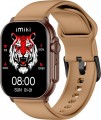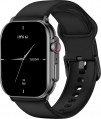The main way to connect a wearable gadget with external devices. For smartwatches and fitness bands (see "Type"), this refers to a connection to a smartphone or tablet, while in the case of watch-phones, it usually refers to headsets.
— Bluetooth. Wireless technology for direct communication of various devices with each other. This is the most popular interface in smartwatches and bracelets: Bluetooth modules can be made very tiny, the communication range even in the earliest versions reaches 10 m, and different generations of Bluetooth are mutually compatible in terms of basic functionality. Specifically, the versions nowadays are as follows:
- v2.0. The earliest standard used in modern wearable gadgets. The possibilities of such a connection are more modest than those of more advanced versions, but they are often quite enough.
- v3.0. A standard that combines classic Bluetooth v 2.0 and a high-speed “add-on” for transferring large amounts of data.
- v4.0. Further, after 3.0, improvement of Bluetooth: in addition to the classic and high-speed format, this version added Bluetooth Low Energy technology. Support of this technology is especially useful in fitness trackers, which usually transmit small amounts of data, but constantly.
- v4.1. Modification of the 4.0 standard described above with improved protection against interference while working with LTE mobile communications.
...i> v4.2. Another improvement of the 4.0 standard, which introduced, in particular, improved data protection and increased connection speed.
- — v 5. The fifth generation of Bluetooth was released in 2016. The key innovation in version 5.0 was the expansion of capabilities related to the Internet of Things. Thus, in the Bluetooth Low Energy protocol, it became possible to double the data transfer rate (up to 2 Mbit/s) at the cost of reducing the range, and also quadruple the range at the cost of reducing the speed; In addition, a number of improvements have been introduced regarding simultaneous work with a large number of connected devices.
- — v 5.1. Update of the version described above v 5.0. In addition to general improvements in the quality and reliability of communication, this update introduced such an interesting feature as determining the direction from which the Bluetooth signal is coming. This makes it possible to determine the location of connected devices with centimeter accuracy.
- —v 5.2. The next, after 5.1, is the fifth generation Bluetooth update. The main innovations in this version are a number of security improvements, additional optimization of power consumption in LE mode and a new audio signal format for synchronizing parallel playback on multiple devices.
- —v 5.3. The Bluetooth v 5.3 wireless communication protocol was introduced at the dawn of 2022. Among the innovations in it, they accelerated the process of negotiating a communication channel between the controller and the device, implemented the function of quickly switching between the operating state in a low duty cycle and a high-speed mode, and improved the throughput and stability of the connection by reducing susceptibility to interference. When unexpected interference occurs in Low Energy mode, the procedure for selecting a communication channel to switch from now on has been accelerated. There are no fundamental innovations in protocol 5.3, but a number of qualitative improvements are evident in it.
Of course, to use all the capabilities of a particular version of Bluetooth, it must be supported not only by the gadget itself, but also by the smartphone/tablet to which it is connected.
The material from which the body of the gadget is made. Some models are available in several versions, made of different materials — for example, aluminium or steel; for such cases, all available options are indicated in the specs at once.
—
Plastic. Plastic is often considered a low-cost option, but this is not true in the case of wearable gadgets: such devices can use different types of plastic, including very advanced, durable and reliable ones. So the overall quality of such a case, usually, directly depends on the price category of the device. The common advantages of all types of plastic are relatively low weight, resistance to moisture, the ability to give the body any colour and shape, as well as low thermal conductivity.
—
Metal. Cases made of metal, for which the manufacturer, for some reason, did not specify the specific composition. However, most often in such cases we are talking about
aluminium or
steel, see below for more details on both. But high-end materials such as
gold or
titanium are rarely hidden under the modest term "metal" — they are usually indicated directly in the specifications. Anyway, in general, metal cases are somewhat stronger and more reliable than plastic ones, they also look more solid, but they are also more expens
...ive.
— Steel. Usually, stainless steel is used for wearable gadgets. It is highly durable and reliable, does not corrode, looks stylish and neat, and is relatively inexpensive — cheaper than many aluminium alloys, not to mention titanium. One of the peculiarities of steel cases is rather heavy weight, but it can be both a disadvantage and an advantage: a massive case creates an additional feeling of reliability and solidity. It should be noted that most gadgets with steel cases have round dials and a traditional design, which is well suited even to a business style, but occasionally there are exceptions.
— Aluminium. Aluminium alloys combine high strength and low weight — much less than steel. But this material is somewhat more expensive. It is also considered well suited for bright youth gadgets, although it is occasionally used in more traditional devices.
— Rubber. A material found in some models of children's beacons and fitness trackers (see "Type"), but almost never used in other types of wearable gadgets. One of the key advantages of rubber is softness, which gives a certain degree of impact protection and makes the case as safe as possible; both are especially important for children's devices. In addition, such a case can be easily made waterproof and even completely sealed, as well as made in any colour. On the other hand, plastic has practically the same advantages (except for softness), and rubber costs a little more (although it is noticeably cheaper than metals).
— Titanium. Titanium alloys are premium materials and are rarely used, mainly in top-tier models of “extreme” gadgets. This material is light and at the same time extremely durable, besides it perfectly holds its shape when struck; however, titanium costs much more than the same aluminium, despite the fact that high reliability is not so often decisive.
— Gold. Gold or gold-plated case turns the gadget into a stylish fashion accessory. Such a case is very expensive, but this cannot be called a disadvantage: the price of the device emphasizes the status of the owner.
— Ceramics. Special high-strength ceramics is another premium material that not only performs a practical function, but also demonstrates the high level of the gadget and the solidity of its owner. On the practical side, in addition to strength and reliability, this material has extremely high scratch resistance, which allows it to retain its looks for a very long time even in not very favorable conditions. At the same time, ceramics do not tolerate strong point impacts.
